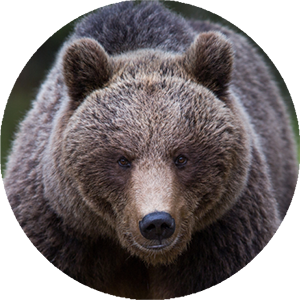Brown Bears and Grizzly Bears
Both of these bears are solitary, unsociable, dangerous creatures—highly coveted trophies that are extremely challenging to hunt. Though they are very similar, there is great debate regarding the classification of brown vs. grizzly bears. According to Boone and Crockett Club, there are distinct differences worthy of note:
“Genetically, this is indeed the same bear across its range. But, morphologically, there are differences. For Boone and Crockett records-keeping purposes, a geographic boundary was established to recognize the two separate body types for Ursus arctos.
“Bears living near the coast (Boone and Crockett’s Alaska brown bear classification) feast on high-protein salmon returning to the rivers each summer. These bears’ body and skull size have adapted to be far larger than bears living further inland. Coastal bears move little, establish themselves on a section of river and spend their lives close to a bounty of fish.
“The life of an interior bear (Boone and Crockett’s grizzly bear classification) is far different. While they may eat fish in some cases, their diet is a wide array of food sources from grubs and berries to migrating caribou and moose calves. More nomadic, these bears also are generally more aggressive as their survival literally hinges on being able to catch and kill their next meal. In order for trophy records to be useful for conservation and management purposes, Boone and Crockett Club recognized that data on the smaller interior bears shouldn’t be lumped with those of the larger coastal bears.”
With the possible exception of the polar bear, Alaskan brown bears are the largest land-dwelling carnivore on earth, with many weighing in at well over 1,000 lbs. Hunting these giants is typically done on foot, via spot and stalk, and is extremely taxing. You’ll need to wear hip boots, rain gear, and, possibly, snow shoes and you’ll navigate a variety of challenging terrain, including through rivers and swamps and along snowy mountainsides in cold, wet weather. Watchful waiting is key, and once a bear is spotted, you’ll need to move quickly and be able to shoot VERY well with a very high-caliber rifle. Wounding one of these beasts without killing it can result in an extremely dangerous situation. Hunts take place in the spring and fall, and salmon fishing as well as black-bear hunting can typically be added to these trips.
Grizzly bears can be hunted in Alaska, the Yukon, and British Columbia, and can be combined with hunts for other species, including moose, caribou, goats, black bears, wolves, and wolverine. Males weigh as much as 500 to 750 lbs., and are excellent swimmers and swift runners (able to reach speeds of 30 mph) despite their size. While not as large as their coastal counterparts, grizzlies are known for their beautiful, thick coats and are a highly prized—and hard-won—trophy. Hunting the grizzly is just as challenging, and sometimes even more dangerous, than hunting the brown bear. Depending on the time of year, you might travel by horse, snow machine, or jet boat, as well as on foot. It may be very cold and very wet and you’ll undoubtedly spend a great deal of time glassing.
Most hunts run 8-14 days and are very expensive at up to $20,000 (sometimes much more). At this time, you can only harvest a brown/grizzly bear every four years in Alaska. You’ll want to be in peak physical condition and bring along high-quality glass as well as a weatherproof rifle. We recommend a .375 with 300-grain bullets for a brown or grizzly bear hunt.
Contact us today to start planning your bear hunt!




